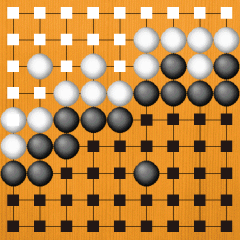 |

Day Three: Capturing stones, surrounding territory |
 |
[4]How to surround territory

(a) Enclosing on a large scale
· The side with more territory wins in Go, so you must surround territory efficiently. First of all, let's give priority to surrounding on a large scale. Please compare White and Black in Dia. 68. Black has used one-space jumps to surround territory on the second line from the edge of the board. The edge of the board is certainly Black's territory, but this is inefficient.
White has played the same number of moves on the third and fourth lines, so he gets a large territory. A comparison makes it clear at a glance: White's territory is much bigger than Black's, so he should win this game. |
 |
Dia. 68
|
|
· In Dia. 69, both sides have surrounded territory on a large scale. This a peaceful game in which both sides have expanded their territories. |
 |
Dia. 69
|
|
· Dia. 70. With 1 to 5, Black encloses the top. White encloses on a large scale with 2 to 6. If White gets all this territory, the game will look favourable for him, but actually there are times you can't secure territory because it is too wide. If, for example, Black invades at 7, there's a possibility that this will become black territory. You can't tell what will happen unless you actually play it out, but please remember that there's a limit to how wide you can play. |
 |
Dia. 70
|
(b) Surrounding efficiently
· Dia. 71. Black plays just in the centre and doesn't secure any territory worthy of the name. White plays in all the corners and should be able to get a little territory in each, so his way of playing is more efficient. |
 |
71図
|
|
· Dia. 72. It's important to play well-balanced moves in the beginning. Black builds a spacious position with 1 to 5. He doesn't yet have definite territory, but he should be able to build quite a wide territory. White plays steadily with 2 to 6; this territory is unlikely to be reduced. Enclose spaciously or steadily: each is an excellent strategy. |
 |
Dia. 72
|
|
· (Application 6). Dia. 73. The black and white stones here are scattered: they are not surrounding territory. They will have to work out ways to enclose territory during the course of the game. |
 |
Dia. 73
|
|
For example, expanding their respective territories with 1 to 4 in Dia. 74 is conceivable. |
 |
Dia. 74
|
|
Alternatively, Black could also link up with 1 and 3 in Dia. 75. Up to 7, Black gets territory in the top right, and up to 8 White gets territory in the top left and at the bottom. |
 |
Dia. 75
|
 |
(c) Enclosing by working together
· In Go, you don't enclose territory right at the beginning. Most often, you play here and there and gradually territory forms. Usually, the stones you scattered around the board in the beginning gradually start to work together and enclose territory. Let's look at an example.
· Dia. 76. Black plays in three different areas with 1 to 5. His strategy is to create influence in each area. In contrast, White builds a tight position with 2 and 4. He then makes a one-space jump to 6, which is a secure way of expanding territory.
Let's compare the two sides. After 9, the black stones that at first seemed to be scattered are working together, and Black looks like getting a wide territory centred on the lower right.
White has build a solid territory centring on the top left, but, if you compare the size, Black's looks more promising. Putting aside the fine points, it's enough if you can just see that Black's territory feels bigger. One's perception or intuition is important in Go. The continuation is shown in the next diagram. |
 |
Dia. 76
|
 |
|
· Dia. 77. Please follow the sequence from Black 1. Both sides enclose their territories up to 18. The final position, with the numbers erased, is shown in the next diagram. |
 |
Dia. 77
|
|
Dia. 78. If we count the territories, we find Black has 34 points and White has 19, so Black has 15 points more. We think you can see how efficient it is to enclose by having your stones work together. |
 |

Dia. 78 |
|
 |
 |

 |
|
 |